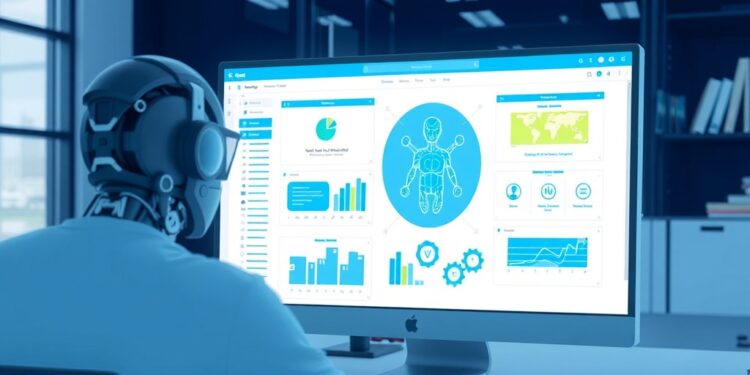
In the evolving landscape of workplace productivity, a recent study published in the esteemed Quarterly Journal of Economics by Oxford University Press has shed light on the transformative effects of artificial intelligence (AI) on customer service operations. The research indicates that the introduction of AI assistance can significantly amplify productivity, particularly for less experienced and lower-skilled employees within the customer service sector. This paper meticulously scrutinizes the interplay between AI tools and employee performance, revealing nuanced outcomes that vary depending on the workers’ skill levels and experiences.
In an era characterized by rapid technological advancements, the capabilities of computers and software have revolutionized industrial practices, enabling automation and efficiency. Despite these advancements, several tasks inherent to customer service—including nuanced email communications, data interpretation, and the creation of presentations—remain challenging for full automation. Historically, tasks governed by explicit rules became prime candidates for automation, causing a marked reduction in demand for labor in routine sectors like data entry and assembly line work. This trend has engendered wage disparities, as the demand for high-skill positions requiring programming and analytical abilities has surged, exacerbating economic inequalities.
The research in question examined the impacts of generative AI on the work of 5,172 customer support agents at a prominent Fortune 500 company specializing in business process software. The study’s findings present a compelling narrative about the role of AI in mediating employee productivity. Notably, the introduction of an innovative chat assistant led to an impressive 15 percent increase in the rate at which agents resolved customer inquiries per hour. The data emphasizes how generative AI serves not merely as a tool, but as a catalyst for enhanced employee engagement and efficiency.
Diving deeper into the research results, a stark contrast emerges between the productivity gains observed among less skilled and more experienced workers. For novice agents, the infusion of AI assistance resulted in a remarkable 30 percent increase in their ability to resolve issues. This enhancement signifies not just a short-term productivity boost, but also indicates a long-term benefit as it accelerates the learning curve for newer employees. The study highlights that AI-assisted agents who had merely two months of experience exhibited performance metrics on par with those who had six months of tenure without AI support.
Conversely, the impact on seasoned employees tells another story. Those who are more proficient and experienced witness modest gains in productivity but paradoxically experience a slight decrease in the quality of their interactions. It poses a significant consideration for organizations that invest in AI technologies; balancing productivity and quality becomes increasingly complex as workforce experience levels diverge.
Another intriguing aspect of the study aligns AI usage with enhanced learning prospects. Agents who more closely adhered to AI recommendations displayed greater improvements in their productivity metrics. As time progressed, the adherence rates to AI guidance increased, revealing a learning curve that plays a crucial role in employee adaptation to new technological ecosystems. The investigation delves into linguistic improvements as well, demonstrating that AI access fosters better English fluency among non-native speakers, unveiling an additional layer to the multi-faceted benefits of generative AI in the workplace.
The implications of AI assistance extend beyond mere numbers. The study presents evidence that AI tools can positively influence customer interactions. Customer service roles often entail high levels of stress due to dealing with frustrated consumers, and the introduction of AI seems to ameliorate the tensions in these exchanges. The results indicate that customers, when engaging with AI-supported agents, showed a notable decline in hostile interactions, inferring that AI could play a pivotal role in improving the overall workplace atmosphere.
As organizations contemplate the adoption of AI solutions, the findings encapsulate a critical understanding of how these technologies might redefine work dynamics in customer service. The diverse impact on employees based on their skill levels underscores the necessity for targeted training and integration strategies that align human capabilities with AI functionalities. This supports not only efficiency but also aids in maintaining a high standard of quality in interactions.
Moreover, the broader economic dimensions of this research touch upon wage inequality and labor market shifts. While generative AI may enhance productivity in frontier sectors, it also raises questions about the economic ramifications for lower-skill jobs that AI can displace. As the demand for skilled labor rises, the discourse around equitable workforce development becomes increasingly pertinent. Fostering a balanced economic environment where technological advancements do not disproportionately disadvantage low-skilled workers is imperative for sustainable growth.
Amid these revelations, it remains essential for researchers and policymakers to monitor the ramifications of such transformative technologies. Questions around legal frameworks, ethical considerations, and workforce transitions warrant ongoing dialogue among stakeholders to ensure the integration of AI within the workforce cultivates positive prospects for all employees, irrespective of their skill levels.
In conclusion, this research presents a comprehensive examination of the myriad ways AI technology is reshaping not only productivity metrics but also employee engagement and customer interactions within the customer service realm. As companies continue to innovate and adopt AI solutions, understanding the subtle dynamics revealed in this study will be critical for achieving successful integration that fosters an equitable and productive work environment.
Subject of Research: People
Article Title: Generative AI at Work
News Publication Date: 4-Feb-2025
Web References: Quarterly Journal of Economics
References: 10.1093/qje/qjae044
Image Credits: N/A
Keywords
Economics
Market economics
Learning processes
Digital data
Generative AI
Inequalities
Tools
Tags: AI in customer serviceautomation in customer supportchallenges of automating customer service taskseconomic inequalities in labor marketsemployee experiences with AI toolsemployee performance and AIgenerative AI impact on employeesOxford University Press research studyskill levels and AI assistancetechnological advancements in workplacestransformative effects of artificial intelligenceworkplace productivity enhancement





